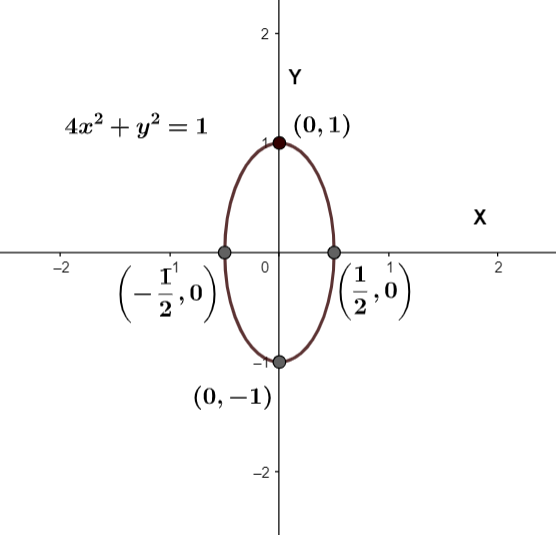
How do you find the center and vertices of the ellipse \[4{{x}^{2}}+{{y}^{2}}=1\]?
Answer
534.9k+ views
Hint: The standard form of equation of ellipse is \[\dfrac{{{x}^{2}}}{{{a}^{2}}}+\dfrac{{{y}^{2}}}{{{b}^{2}}}=1\]. And a, b are any real numbers. As we can see that here the coefficients of the square terms are in the denominator, so to find the center and vertices using the equation, we first have to take the coefficient of the \[{{x}^{2}}\] in the denominator. The vertices are similar to the intercepts of the ellipse. The centre of the ellipse with the equation \[\dfrac{{{x}^{2}}}{{{a}^{2}}}+\dfrac{{{y}^{2}}}{{{b}^{2}}}=1\] is \[x=0\And y=0\].
Complete step by step solution:
We are given the equation of the ellipse as \[4{{x}^{2}}+{{y}^{2}}=1\]. Comparing it with the standard form of the equation \[\dfrac{{{x}^{2}}}{{{a}^{2}}}+\dfrac{{{y}^{2}}}{{{b}^{2}}}=1\], we get \[{{a}^{2}}=\dfrac{1}{4}\And {{b}^{2}}=1\]. Taking the square root of both these equations to find the values, we get \[a=\dfrac{1}{2}\And b=1\].
We know that to find the center of the ellipse, we have to equate the x and y with zero. Thus, we get coordinates of centre as \[(0,0)\].
The vertices are the intercepts of the ellipse; thus, we can find them by substituting x and y to be zero separately.
Substituting \[x=0\], we get
\[\begin{align}
& \Rightarrow 4{{(0)}^{2}}+{{y}^{2}}=1 \\
& \Rightarrow {{y}^{2}}=1 \\
\end{align}\]
Solving the above equation, we get \[y=\pm 1\]. Thus, the coordinates of the two vertices are \[\left( 0,1 \right)\And \left( 0,-1 \right)\].
Substituting \[y=0\],
\[\begin{align}
& \Rightarrow 4{{x}^{2}}+{{0}^{2}}=1 \\
& \Rightarrow 4{{x}^{2}}=1 \\
\end{align}\]
Solving the above equation, we get \[x=\pm \dfrac{1}{2}\]. Thus, the coordinates of the other two vertices are \[\left( \dfrac{1}{2},0 \right)\And \left( -\dfrac{1}{2},0 \right)\].
We can graph the ellipse as,

Note: Here, as the coefficient of the \[{{x}^{2}}\] was not of the form of \[\dfrac{1}{{{a}^{2}}}\]. We have to equate this with the given coefficient, to find the value of the a. we can do this as, \[\dfrac{1}{{{a}^{2}}}=4\]. Thus, on solving this equation, we get \[a=\dfrac{1}{2}\].
Complete step by step solution:
We are given the equation of the ellipse as \[4{{x}^{2}}+{{y}^{2}}=1\]. Comparing it with the standard form of the equation \[\dfrac{{{x}^{2}}}{{{a}^{2}}}+\dfrac{{{y}^{2}}}{{{b}^{2}}}=1\], we get \[{{a}^{2}}=\dfrac{1}{4}\And {{b}^{2}}=1\]. Taking the square root of both these equations to find the values, we get \[a=\dfrac{1}{2}\And b=1\].
We know that to find the center of the ellipse, we have to equate the x and y with zero. Thus, we get coordinates of centre as \[(0,0)\].
The vertices are the intercepts of the ellipse; thus, we can find them by substituting x and y to be zero separately.
Substituting \[x=0\], we get
\[\begin{align}
& \Rightarrow 4{{(0)}^{2}}+{{y}^{2}}=1 \\
& \Rightarrow {{y}^{2}}=1 \\
\end{align}\]
Solving the above equation, we get \[y=\pm 1\]. Thus, the coordinates of the two vertices are \[\left( 0,1 \right)\And \left( 0,-1 \right)\].
Substituting \[y=0\],
\[\begin{align}
& \Rightarrow 4{{x}^{2}}+{{0}^{2}}=1 \\
& \Rightarrow 4{{x}^{2}}=1 \\
\end{align}\]
Solving the above equation, we get \[x=\pm \dfrac{1}{2}\]. Thus, the coordinates of the other two vertices are \[\left( \dfrac{1}{2},0 \right)\And \left( -\dfrac{1}{2},0 \right)\].
We can graph the ellipse as,

Note: Here, as the coefficient of the \[{{x}^{2}}\] was not of the form of \[\dfrac{1}{{{a}^{2}}}\]. We have to equate this with the given coefficient, to find the value of the a. we can do this as, \[\dfrac{1}{{{a}^{2}}}=4\]. Thus, on solving this equation, we get \[a=\dfrac{1}{2}\].
Recently Updated Pages
Master Class 11 Business Studies: Engaging Questions & Answers for Success

Master Class 11 Computer Science: Engaging Questions & Answers for Success

Master Class 11 Maths: Engaging Questions & Answers for Success

Master Class 11 Chemistry: Engaging Questions & Answers for Success

Master Class 11 Economics: Engaging Questions & Answers for Success

Master Class 11 Accountancy: Engaging Questions & Answers for Success

Trending doubts
What is meant by exothermic and endothermic reactions class 11 chemistry CBSE

10 examples of friction in our daily life

One Metric ton is equal to kg A 10000 B 1000 C 100 class 11 physics CBSE

1 Quintal is equal to a 110 kg b 10 kg c 100kg d 1000 class 11 physics CBSE

Difference Between Prokaryotic Cells and Eukaryotic Cells

What are Quantum numbers Explain the quantum number class 11 chemistry CBSE




